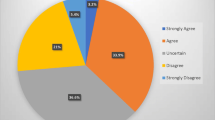Abstract
California Assembly Bill AB487 mandates that all practicing physicians are required to obtain 12 h of Continuing Medical Education in Pain Management and End of Life Care before the year 2006 in order to renew their state license to practice medicine. In order to determine the effectiveness of this bill in influencing the practice of medicine, we conducted the first of five planned annual Pain Management seminars and utilized physician questionnaires to determine possible practice changes as a result of this seminar. Eighty-one physicians representing 17 multiple specialties of medicine enrolled in this seminar. The topics included: management of malignant and non-malignant pain, pharmacology and management of side effects of opiate and non-opiate analgesics, and adjunctive therapies including depression management and spirituality issues. Physicians were asked to respond to an immediate post-seminar questionnaire and were subsequently queried 4 months following the conference. Fifty-one out of 81 physician registrants responded to an immediate post-attendance questionnaire, and 31 responded to the 4-month follow-up questionnaire. Responses included:
Early | Late | |
I will change/have changed my practice | 34 | 28 |
I see no need to change my practice | 6 | 2 |
I will await further information | 7 | 1 |
No response regarding practice change | 4 | |
Responses of those who changed their practices included: | ||
Increased use of known modalities for pain control | 21 | |
Earlier referrals to specialists | 14 | |
More attention to psychosocial aspects | 14 | |
Use of new drugs/modalities of care | 11 | |
This audience represents the most motivated group of practitioners electing to receive Pain Management Education long before the mandated deadline. Sixty-seven percent expressed an interest in changing their practice following this intensive educational experience. Ninety percent responding to the follow-up evaluation indicated that their practices had changed, suggesting that this seminar series is effective in altering physician practice patterns (supported by Cancer Center Support Grant CA 33572 and Sarnat Foundation).
Similar content being viewed by others
References
Jacox A, Carr DB et al (1994) Management of Cancer Pain: Adults. Clinical Practice Guideline 9: Agency for Health Care Policy Research US Dept of Health and Human Services 9:94–0592.
Field M, Cassel C (1998) Approaching Death: Improving Care at the End of Life. National Academy Press 33:1–3.
(1995) The SUPPORT Principal Investigators. A Controlled Trial to Improve Care for Seriously Ill Hosptialized Patients. JAMA 274:1591.
Pantel ES. Breaking down the barriers to effective pain management. Report to the Commissioner of Health, Barbara A De Buono, M D, M P H, from the New York State Public Health Council 1998.
Foley KM (1995) Pain Relief into Practice: Rhetoric Without Reform. J Clin Oncol 13:2149–2151.
Author information
Authors and Affiliations
Corresponding author
Additional information
Supported in part by NCI Cancer Center Support Grant CA 33572 and Sarnat Foundation
Reported in part in Proc. American Association for Cancer Education, Little Rock, AR, USA, October, 2003
Rights and permissions
About this article
Cite this article
Leong, L., Ninnis, J., Slatkin, N. et al. Evaluating the Impact of Pain Management (PM) Education on Physician Practice Patterns—A Continuing Medical Education (CME) Outcomes Study. J Canc Educ 25, 224–228 (2010). https://doi.org/10.1007/s13187-010-0040-y
Received:
Accepted:
Published:
Issue Date:
DOI: https://doi.org/10.1007/s13187-010-0040-y




